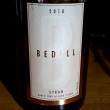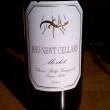Thoughts on the Final Niagara Harvest Report of ’09

By Bryan Calandrelli, Niagara Escarpment Editor
The harvest season in Niagara has just about come to a close, and I’ve spent the last two days harvesting, crushing, and pressing grapes that hung into November. I’m exhausted and I can tell there is a sense of relief in the air that the wineries in our area don’t have to constantly fuss over weather forecasts anymore.
I’ve personally seen the whole spectrum of diseased grapes this year — underripe one, fragile one and damn-near perfect ones.. So it’s become increasingly frustrating to me to read any sweeping speculation — including my own — about 2009.
I’ve also come to the realization that a declaration of the “perfect” vintage (2007) isn’t always as beneficial as it seems. I find myself instantly giving thumbs up or down on a 2007 red, thinking “If they couldn’t make a good merlot in 2007, then it just isn’t going to happen.” I’m not proud of this but knowing everything I know about that season, it’s unavoidable.
Let’s face it. It’s not easy to grow grapes in New York State. Cool-climate viticulture is extreme farming and if a wine is quaffable and pleasant at the end of the day, then someone worked his or her ass off to make it that way. Every year is a tough year and that should make the consumer appreciate the wine even more.
Listening to the spin on the topic of this year’s harvest has been fun. By already declaring 2009 a bad year, I think many simply are lowering expectations, but perhaps the most common spin has been, “The grapes have great acid this year.” Well I can say the same about the wild grapes growing in my back yard but I won’t be making wine from them any time soon.
The one example of spin I do find palatable is, “We are getting good flavors in the grapes.” This is probably the most important of all. Alcohol, acid and tannin can all be easily manipulated while flavor cannot be.
In my conversations this year with local growers, I’ve been able to pick up a few signs that they would rather not be matter of fact when discussing their crop. I’ve gotten used to a wink or grin when they discuss brix levels. I’ve even come to appreciate sarcasm as a response to vintage questions. One winemaker’s response of “best vintage yet” still sums up the tone of the season for me.
A sense of humor is required when you rely on Mother Nature.
Overall, the surprising quality of the reds and whites I’ve tasted these past few weeks though is made even more amazing knowing the challenges each grower and winemaker faced this year. I just hope people don’t let some of the speculation prevent them from trying a 2009 New York wine in the future.
















Personally, I liked 2008 grapes better than 2007. While 2007 gave us an indication of how nice California must be to farm in (every day was sunny), I thought the fruit was less complex in flavor than 2008. In 2007 I did enjoy waking up in the morning knowing that it was going to be sunny and warm and that I didn’t have to go through the acrobatics of scheduling and reacting to weather changes that was the hallmark of 2009.
We dropped our fruit to 1-2 clusters per shoot once we were through July and realized we were not likely to get the heat we needed. We use Scott Henry trellising with narrow rows and can support up to 4 tons/acre here on this site. We further reduced the crop at veraison by clipping any cluster that appeared to be lagging behind the others, which ensured consistency. The net result was we cropped at 1.5 tons per acre or less in the vineyard this year. We purchased more outside fruit to keep our production volume up. Of course, all of this added up to more cost for less fruit. The fruit we did get, however, was well balanced and had brix ranging from 21 to 23 with acidity running a bit above expectations. I think the wines from most producers will be fine - everyone was paying attention.
I would be happy to never see another year like this - it was a tremendous amount of effort.
I decided to purchase the seeds for the Dwarf Cavendish Banana variety
due to the fact that I plan on cultivating the plant in a hydroponic environment.
Starting the plant from a soilless media would be required,
due to the seedlings later introduction into a top feed drip hydroponic system.